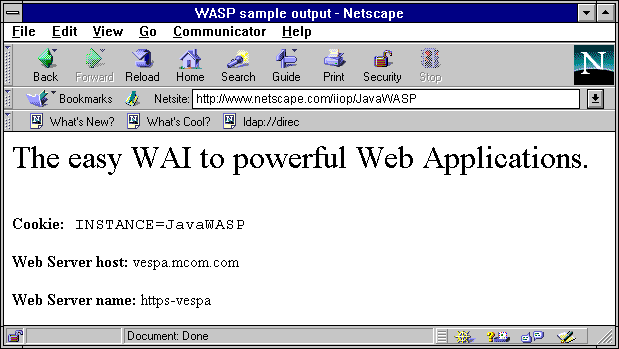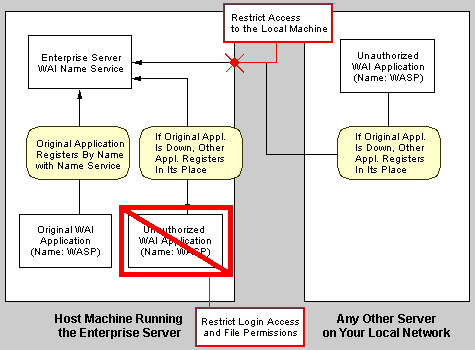Chapter 8
Security Guidelines for Using WAI
Run method (or, in C programs, the corresponding C function of the type WAIRunFunction) in your web service application class.
This section discusses some of the potential security concerns that may arise from the way in which the web server finds your application process. Before you enable WAI on your server, make sure to read this chapter thoroughly.
How the Server Finds Your Application
When you start up your WAI application for the first time, your application registers with the web server's built-in name service. The web server saves the information with the name service.
In order to access your service, end users enter a URL (or click on a link) that contains the name of your service. When this URL is requested, the web server uses its built-in name service to find the registered WAI application with the same name. The server then invokes the Run method in your web application service class.
For example, when you start the WASP example (which is provided with the web server) for the first time, the example registers itself to the web server with the name WASP (for the C++ example) or JavaWASP (for the Java example). End users can access the service through the URL http://hostname:port/iiop/WASP (or JavaWASP).
By default, the basic object adapter (BOA) in the web server is set to listen only to the local host (the loopback address, 127.0.0.1), not to a network IP address. This configuration assumes that you plan to run your web application services on the same machine as your web server.
Although it is possible to enable the web server's BOA to accept requests from remote machines, you should be aware of the potential security issues surrounding this configuration before choosing to set up your web server in this way. The rest of this chapter explains these potential security concerns.
Potential Security Concerns
When running WAI applications with your web server, the following scenarios could occur:
- Someone could replace a web service by running another program that registers under the same name. Potentially, a user could write a program that registers itself under the same name as an existing web service. If the original application that provides the service stops running (for example, if it crashes), another application registered under the same name can take its place.
For example, suppose you are running the WASP example. Someone else
could write a program that registered itself under the same name (WASP)
and run the program on the web server's host machine. If the original
WASP application terminates, the web server's name service will find the
other service registered as WASP, and the web server will use that service.

Recommended Guidelines
In order to reduce the possibility that security problems might occur, Netscape recommends that you follow these guidelines:- (For 3.0 servers only) Restrict osagent so that it only accepts connections from the local host. Although the web server primarily uses its built-in name service to register WAI applications,
osagentcan also register WAI applications if the name service is down.
To configure
osagent to accept connections only from the local host
machine, specify the -a option with the argument 127.0.0.1 (localhost):
osagent -a 127.0.0.1

Enabling IIOP Connections from Other Machines
Although Netscape recommends running WAI applications only on the web server's host machine, it is possible to run WAI applications on other machines and have CORBA object implementations on other machines interact with the web servers.Configuring Your Web Server
To enable the web server to register and find WAI applications running on other machines, you need to configure the web server to use its network IP address instead of the localhost IP address (127.0.0.1). In theobj.conf file for your server, find the Init directive that calls the IIOPinit function. Use the OAipaddr parameter to specify the IP address that the BOA uses. For example, if you want the BOA set up to use the IP address 204.200.215.98 instead of the local hosr, use the following syntax:
Init LateInit="yes" fn="IIOPinit" OAipaddr="204.200.215.98"For more information, see "Configuring the Web Server's ORB".
(3.0 only) Running osagent
If you are not restricting the ORB to the local host machine only, you do not need to specify the -a flag when running the osagent utility.
This flag restricts osagent to finding WAI applications on the local host machine only. Without this flag specified, osagent will be able to find applications running on any machine in your local network.
[Contents] [Previous] [Next] [Index]
Last Updated: 12/04/97 16:12:44
Any sample code included above is provided for your use on an "AS IS" basis, under the Netscape License Agreement - Terms of Use